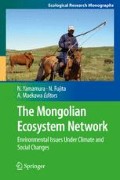Abstract
Mongolia is located in a vegetation transition zone between the Siberian taiga, forest steppes, steppes, desert steppes, and the Central Asian desert region where the vegetation changes from the northern forest to the central steppe and southern desert. There is also a unique combination of geological conditions and topography. These variations in environmental factors in different parts of the country specify Mongolia’s soil distribution, which changes from north to south following a longitudinal zonal schema. The zones include (1) a mountain taiga zone with cryomorphic taiga soils, (2) a mountain forest-steppe zone with Chernozems, dark Kastanozems, dark-colored forest soils, and derno taiga soils, (3) a dry-steppe zone with Kastanozems, (4) a semidesert zone with brown semidesert soils, and (5) a desert zone with gray-brown desert soils and extremely arid desert “borzon” soils. Typical forest-steppe and steppe soil is a chestnut soil, Kastanozem. In the Gobi-Steppe, calcisols are distributed. In this chapter, Mongolian soils are characterized and the pedogenesis is summarized.
Access this chapter
Tax calculation will be finalised at checkout
Purchases are for personal use only
References
Asano M, Tamura K, Kawada K, Higashi T (2007) Morphological and physico-chemical characteristics of soils in a steppe region of the Kherlen River basin, Mongolia. J Hydrol 333:100–108.
Dorzgotov D. (2003) Soils of Mongolia. Admon, Ulaanbaatar (in Mongolia with English abstract)
Driessen P., Deckers J., Spaargaren O. (2001) Lecture notes of the major soils of the world. World Soil Resources Reports 94, FAO, Rome, pp233–236.
Feng, Z.-D., Wang, W.G., Guo, L.L., Khosbayar, P., Narantsetseg, T., Jull, A.J.T., An, C.B., Li, X.Q., Zhang, H.C., MaZ, Y.Z., 2005. Lacustrine and eolian records of Holocene climate changes in the Mongolian Plateau: preliminary results. Quat. Int. 136, 25–32.
Horiuchi, K., Minoura, K., Hoshino, K., Oda, T., Nakamura, T., Kawai, T. 2000. Paleoenvironmental history of Lake Baikal during the last 23,000 years: evidence from sedimentary and mineralogical analyses. Palaeogeogr., Palaeoclimatol. Palaeoecol. 157, 95–108.
Opp, C., Haase, D., Khakimov, V. 2000. Soils and soil processes in the Tyvinian part of the Uvs-noor basin. Polish. J. Soil Sci. 8, 71–80.
Author information
Authors and Affiliations
Corresponding author
Editor information
Editors and Affiliations
Rights and permissions
Copyright information
© 2013 Springer Japan
About this chapter
Cite this chapter
Tamura, K., Asano, M., Jamsran, U. (2013). Soil Diversity in Mongolia. In: Yamamura, N., Fujita, N., Maekawa, A. (eds) The Mongolian Ecosystem Network. Ecological Research Monographs. Springer, Tokyo. https://doi.org/10.1007/978-4-431-54052-6_8
Download citation
DOI: https://doi.org/10.1007/978-4-431-54052-6_8
Published:
Publisher Name: Springer, Tokyo
Print ISBN: 978-4-431-54051-9
Online ISBN: 978-4-431-54052-6
eBook Packages: Biomedical and Life SciencesBiomedical and Life Sciences (R0)

